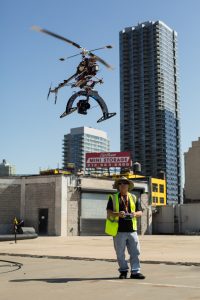 Chicago's Lake Shore Drive captured by a SkyPan International aerial photography drone
Chicago's Lake Shore Drive captured by a SkyPan International aerial photography drone
CHICAGO, IL—SkyPan International, the company that pioneered aerial view photography, is celebrating its 30th anniversary, underscoring the critical value that aerial photography adds to architectural planning and real estate site design.
Headquartered in Chicago, SkyPan has been instrumental in the design and development of milestone projects, such as the Hudson Yards megaproject in New York City, the Ritz-Carlton Residences in Waikiki Beach, the Four Seasons at the Surf Club in Surfside, FL, the Metropolitan in Los Angeles, and the Vista Tower in Chicago.
“SkyPan has shot aerial views of nearly every high rise greater than 20 stories in Chicago since 1988,” says founder and president Mark Segal in an exclusive interview with GlobeSt.com. Segal recalls starting in the company as a “very little boy, changing Hasselblad magazines” in a helicopter while his father made photographs. “We have also worked on every supertall building in Manhattan and Brooklyn in the past 15 years, producing 360º spherical imagery for pre-development design, for investment presentations, and for pre-construction marketing and unit sales.”
Listen to our exclusive audio interview with Mark Segal in the player below. If you don't see a player, click here to listen to the interview.
Leveraging the ability to visualize an unbuilt space and capture the scene from the skies is a fast-growing trend in high-end real estate. Today, SkyPan depends on aerial drone photography increasingly, to deliver views from exact floor heights in striking daylight, sunset and dusk conditions.
“We used helicopters primarily for many years until things became so restrictive that you couldn't fly helicopters in unauthorized locations, especially Washington, DC, where I grew up,” Segal says. “Then, of course, after 9/11 there were major restrictions on how low helicopters could fly in inner cities. Most don't go below 1,200 or 1,500 feet, for both safety reasons and noise abatement issues. So drones have been slowly progressing and filling up that gap from ground level up to 5, 6, 700 feet for the last 15 to 20 years.”
 Marc Segal, founder and president of SkyPan international, flying one of the company's photo drones
Marc Segal, founder and president of SkyPan international, flying one of the company's photo dronesFor developers and brokers, these photos can enhance real estate pricing, investor and lender buy-in and accelerate pre-sales and pre-leasing. For architects and building designers, it's about ensuring that the building makes sense in the neighborhood. And it requires extensive planning.
“We propose shooting imagery at different levels above a future building site, whether it's mid-rise or high-rise, to show the future view, which helps the architectural and planning team to design a building that fits well into that particular environment,” Segal says. “It could be orientation of the building. It could be the surface of the building. It could be the ins and outs of the surface of different sides of the building, all utilizing view photography to optimize the best building that can be built, and practicality-wise, also from a cost standpoint, how that helps as well, based also upon the maximum height allowed for that building footprint.”
 SkyPan International drone photo showing Philadelphia's Center City at dusk.
SkyPan International drone photo showing Philadelphia's Center City at dusk.As cities expand vertically, the demand for aerial photography in planning, design, construction and sales will accelerate. Aerial drone operations can provide cost-effective view captures.
“Delivering the finely detailed photography in this demanding industry requires an advanced robotic flying system, which SkyPan has built and mastered,” says Segal. “We've established a 30-year history of surpassing client expectations, and we plan to continue exceeding them for the next three decades.”
© Touchpoint Markets, All Rights Reserved. Request academic re-use from www.copyright.com. All other uses, submit a request to [email protected]. For more inforrmation visit Asset & Logo Licensing.







